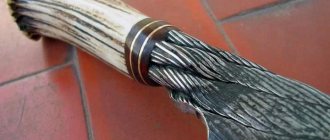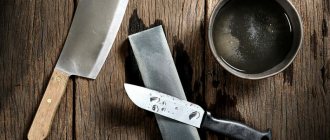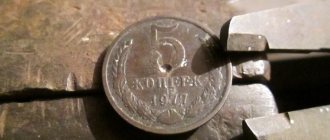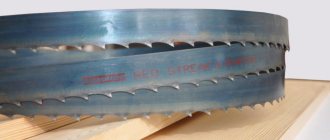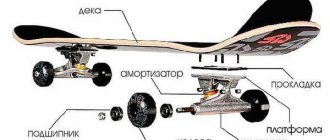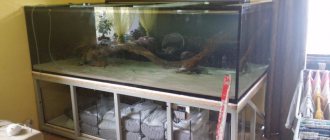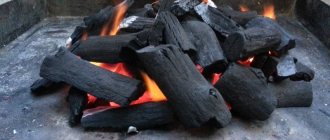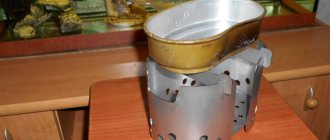Buying a knife made of high-quality steel is, of course, not a problem. If there is not enough assortment of regular or branded blades, you can find a specialist who works on an individual order.
However, you can go another way - make a knife yourself. You most likely won’t be able to forge the perfect blade the first time, but who knows...
A homemade knife made from cable is a worthwhile undertaking; the result can be a high-quality blade with a visible pattern on the blade, formed by mixing layers of metal during the process of forging it.
Material selection
In our time, only true connoisseurs of this craft engage in blade making. However, even a novice blacksmith and anyone can try to forge a homemade knife.
The easiest way to do this is from a piece of thick reinforcement, an old file or a piece of a car spring. It will be a little more difficult to unforge the drill or bearing race. You can get an interesting result from a spun chain from a chainsaw or car engine.
Another material that, after forging, can become a high-quality blade is cable. Its cores are made of carbon steel, capable of holding an edge well after hardening. If you manage to preserve the braided pattern after forging, you can get a very original blade, vaguely reminiscent of wild Damascus steel.
What do you need to know to figure out how to make a knife from rope? Two important nuances: first, whether the properties of the high-carbon material will be preserved during processing; the second is whether a visible pattern will appear on the blade, gracefully turning into a sharpened edge.
Damascus steel
Previously, sharp, flexible and reliable blades with a patterned pattern on the blade were called damask blades (according to one version, from the province of Fulad in Persia, where they were made). Such characteristics and visible effects were achieved using various methods.
Steel could be smelted in a crucible by metallurgical casting, experimenting with the composition of the material. Another option is to “weld” steel strips of different hardnesses in a forge and then forge the resulting workpiece. Blades forged by blacksmiths using a special technique began to be called Damascus.
They differ precisely in the manufacturing method and technology, and not in the characteristics and degree of expression of the pattern. Having unforged a knife from a cable, you can try to create a blade with your own hands that vaguely resembles such material. And although the pattern on the blade is not an end in itself, it is still a distinctive feature of Damascus steel.
Video in case of a zombie apocalypse: how to forge a katana from a spring and a tomahawk from a wrench
When the Apocalypse happens and new dark times come, these blacksmiths will become the most useful and revered people on the planet.
They know how to make weapons from the most inappropriate materials, real garbage that they managed to find in a landfill. Katanas made from springs, tomahawks made from rebar, trench knives made from gears, daggers made from drills - and all these are real weapons, and not some trash crafts from Crazy Hands. Watching a blacksmith forge a katana is interesting. Watching him do this from springs found in a landfill is doubly interesting. We have collected the most interesting and extraordinary videos with similar tricks.
Blacksmithing tools and materials
To forge a knife from a cable with your own hands, you need to master the craft of a blacksmith at least at a minimum level. To do this, you will need a pair of hammers: one massive (up to 2 kg), the other lighter (up to 0.5 kg) for fine work, pliers, an anvil and a homemade furnace (forge crucible) with forced air supply.
The manufacturing process cannot be done without a grinder, a sharpening machine, or electric welding. You will need a vice and an adjustable wrench. The fuel for the crucible can be charcoal from rocks that produce great heat, because the workpiece will have to be heated to a temperature of over 1200 ° C.
For better “welding”, you can use borax as a flux. It removes scale and prevents carbon from burning out of the material. It is also necessary to prepare the oil for hardening and ensure safety precautions.
Being able to use someone's blacksmith shop or business forge with a mechanical hammer will make the task much easier.
Forging knives at home with your own hands, forging technology
What is a good knife
First, let's agree on the functional purpose of the knife that you are going to make with your own hands. Most likely, the best choice will be to focus on making a high-quality hunting knife. With hunting knives, we also need clarity: which one is the most versatile?
Experienced hunters may have substantial collections of hunting knives of varying sizes and quality, but they only go hunting with one. Rope knife.
He will be the most suitable. After analysis and surveys in hunting sources, a description of the average hunter’s knife appeared, which can be considered the most universal. For Russian hunting conditions, this would be a knife of medium size with the following dimensions:
- The blade can be from 12 to 14 centimeters long, and no more than 3 cm wide.
- The thickness of the blade is approximately 3 - 4 mm.
- The total length of the knife ranges from 23 to 27 centimeters.
Steel and only steel
The choice of metal is limited, or more precisely, you have no choice at all. Only steel for forging knives, no options. Let's figure out what steel is in principle: it is an alloy of iron and carbon.
The typical carbon content range in steel is from 0.1% to 2.5%. The higher the level of its content, the stronger and more resistant the steel is to external influences, but it immediately loses its ductility and toughness.
Properties of steel that have the most direct impact on the good quality of the product:
- High wear resistance depends on the hardness of the steel, which in turn depends on the carbon content of the alloy.
- High strength – maintaining the integrity of the product under the influence of external forces.
- Hardness is its resistance to deformation.
- High ductility is the ability of a steel product to bend under the influence of external forces and then restore its shape.
- Red resistance is the resistance of a metal to high temperatures. Hard grades of steel are the most red-resistant.
It is important that all five indicators are closely interrelated.
The more ductile the steel grade, for example, the lower its hardness. The properties of alloys can be controlled using additives and alloying elements. Now about doping. This is the targeted addition of additives to metal to change various properties for the better. Steel is not alloyed with anything: nickel, molybdenum, cobalt, etc.
We are interested in alloy tool steel with the properties described above. There are many brands of high-quality metals; their characteristics can be found in numerous reference books and manuals.
It is enough for us to understand the general principles in order to find a suitable steel for our knife. You don’t need to go far to get it; a knife is forged from bearings, files, springs, drills and even metal cables. In each case there are technical nuances, but the general rules for forging knives at home are the same and strict.
This is not about beauty, but about the shape of the blade, which must be selected and sketched at the start of the preparatory work. There are few basic forms of blade profiles: dagger, straight spine, profiles with a raised or lowered spine line, finca or bowie, goat leg, tanto.
Let us immediately note that, for example, “tanto” or finka and “bowie” refer to bladed weapons.
Knife forging tools
What tools are needed for forging:
- large hammer up to 4 kg and small hammer up to 1 kg;
- anvil;
- welding machine and grinder;
- grinder;
- bake;
- pliers and an adjustable wrench.
The main requirement for such a stove is to obtain a temperature from 900° to 1200° for quite a long time. Thick sheet metal is best. A mandatory tube for air to enter the stove. You can heat the stove with regular charcoal.
Knife from a drill, stages of work:
- We understand drills and steel . A drill is one of the most popular sources of steel for amateur blacksmiths. In fact, P6M5 steel, alloyed with tungsten and molybdenum, has excellent characteristics for a future cool knife: it is extremely durable, highly resistant to wear and is also easy to sharpen, which is especially important for knives. Similar steel on imported, excluding Chinese, drills is designated as HHS - High Speed Steel, steel for working at high speeds. The best option would be a drill made of steel, to which cobalt has been added in addition to tungsten and molybdenum; it is even more stable and is called R6M5K5. Well, imported drills will become HHS-Co in this case. So, remember: we are looking for domestic drills made of P5M5 with the addition of cobalt, or imported ones, excluding Chinese) HHS, also with the addition of Co. If you have a large drill in your hands, look at it carefully. They usually consist of two parts: a shank made of the most common steel and a working spiral made of the R6M5 steel we need. The boundary can be determined by sparks when turning a drill along its length. The sparkle on a section of alloy steel will be reddish and sparse. On a section of ordinary steel, the sparks will come out yellow and the sheaf will be large.
- Steel firing . This is a simple and “calm” stage of work. You need to light the oven and heat the workpiece in it to about 600° - 700°, maintain this mode for about four hours, then let the stove cool down along with the workpiece. Attention! This stage is not described in many sources and manuals. Why do this? The fact is that most artisan craftsmen make knives from ready-made and hardened tools. Firing them is necessary precisely in such cases, otherwise during further forging, unnecessary stress may arise in the metal structure. For reference: a temperature of 700° can be easily checked using salt - at this temperature it begins to melt.
- Warming up the drill . We flood the stove with air supply, after heating the coals, place the drill in the stove using pliers. If you are forging a knife for the first time, you may make a mistake in determining the heating temperature - either overheat or underheat. In any case, the heating temperature should be above 1000° with an orange color of the workpiece. Immediately the drill is removed from the stove and the shank is clamped in a vice. The very first and most urgent thing is to straighten the drill spiral by clamping the tip with an adjustable wrench. If you do not have time to untwist the spiral, the drill may break. If the spiral does not unwind in one go, you can heat the drill again. As a result, you need to get an even strip of steel.
- Forging and rolling . We heat the steel strip again and begin to level it with blows of a heavy hammer. As a result, the strip should become wider and thinner: from 4 to 5 mm. Forging a knife means constant control of the color of the steel strip. If it begins to fade and cherry shades appear, immediately put it in the oven to heat up again.
- Attention! The main rule of the stove: it is better to overheat and even overheat than to break a cooled product with hammer blows. To help blacksmiths, there is a special scale of temperatures and colors of steel. If at low temperatures of 500° - 600° the steel will be dark brown, then at 1000° the steel will turn orange. Well, at the highest heating up to 1300° it will become dazzling white.
- Forging the blade tip . One of the most difficult stages is essentially the forging of a knife. The blade needs to be given the desired shape without changing the thickness - you have already achieved the desired thickness of 4 - 5 mm in the previous stages. Some practice is needed here: the tip needs to be gradually rounded, and the blade must be simultaneously pulled out in length. This job may not work out the first time, be prepared for such a situation. You have a personal quality called “patience,” right?
- Forging the cutting edge . This is also a difficult and important stage. It is performed with a small hammer: with careful blows, the cutting edge is made as thin as possible, starting from the middle of the blade. The blade should remain straight. At this stage, heating the workpiece is also extremely important: monitor the color and, if necessary, heat it in the stove.
- Shank forging . Everything is much simpler here. Heat the shank in the oven and roll it out with a large hammer. The shape will depend on your choice of handle design, which is not covered in this review.
- Grinding . A rewarding and enjoyable job: removing excess layers and unevenness, leveling the surface to a shiny state is a pleasure. It should be remembered that when grinding the thickness will decrease, up to 2 mm may be lost. As a result, the knife will become lighter and thinner. Sharpening is also done at this stage.
- Knife hardening . Do not neglect this stage under any circumstances, despite the fact that your knife looks great and seems completely ready for use. The main working properties of the knife will depend on hardening. After grinding and complete cooling, the knife is heated in the oven until it turns orange or light red, the temperature is approximately 500° - 700°. Then it is quickly dipped into salted water or oil. In water, the steel begins to “tremble” - this is the hardening process. Some perform another operation “on the path”: they release the blade. Vacation consists of a slight final heating until a thin orange film appears: immediately remove the knife from the stove and let it cool on its own.
Preparatory operations
To make a knife from a cable, first of all you need to sketch it out on paper. Then you will have to find a suitable material. It is necessary to check it and at least remotely determine the carbon composition in it.
It depends on this whether the future blade will be hardened, whether it will hold an edge, and whether it will be possible to carry out forge “welding.” The test is carried out for sparks from a grindstone. A moderately dense orange sheaf of them will mean that welding is possible; the steel contains about 1% carbon, which is enough for hardening.
Next you need to cut a piece of cable to the required length. At this stage, the method of manufacturing the handle is determined. It can be made from a single piece of cable without forging. The knife will look original, but have decent weight.
Another option is to electric weld a reinforcement rod to a section of cable. It is convenient to hold on to such a handle when heating the workpiece in the crucible and processing it with hammers. You can then make a handle on it or, by riveting it, install decorative overlays.
Before starting work, the cable is tightened with steel wire clamps in several places. This is done so that during the heating process the thin wires do not unravel.
KNIFE FROM REINFORCEMENT
10.04.2019
|In Armature
|By SEO
Long products
- Rebar, wire rod
- Beam, channel
- Corner
- Circle
- Stripe, square
Sheet metal
- Hot-smoked sheet
- Cotton sheet
- Galvanized sheet
- Corrugated sheet
- Expanded metal sheet (PVL)
- Stainless steel sheet
Pipes
- Pipes h/d
- Cold pipes
- VGP, electric welded pipes
- Stainless steel pipes
- Pipeline accessories
Stainless steel
- Circle, square, hexagon
- Strip, corner
- Stainless steel pipes
- Stainless steel sheet
- Stainless steel hardware
- Accessories for stair railings
- Pipeline details
Hardware and metal raw materials
- Calibration, silver
- Wire, ropes
- Mesh, tape
- Radiators, electrodes
Non-ferrous metals
- Aluminium, duralumin
- Copper, bronze, brass
- Tin
- Lead
- Zinc
The next step is to forge the drill and roll the metal to an acceptable thickness. We apply the blows very carefully and try to apply only as much effort as is required to slightly deform the hot metal. Next, we weld the workpiece to the reinforcement and heat it up. Forging a knife from a drill. Before tempering, the blade should be cleaned of possible scale and then heated again. Having chosen the most suitable profile for you, you can safely begin creating a sketch. If you couldn't do it in one go, that's okay. Therefore, it is from these items that folk craftsmen make hand-forged knives.
Rebar knife
In fairness, it should be noted that a knife from a spring can be made by simply cutting out the profile of the knife with further sharpening and hardening. As noted earlier, hardening a knife is one of the most important stages of its manufacture. It is best to make the shank of a knife from a file under an overhead handle. Drills have become very popular when forging knives due to the alloy steel R6M5 used in them, which is durable, easy to sharpen and wear-resistant. To do this, it will be enough to read the full description of the steel grade and its use in the Steel and Alloys Brand, and then use a product made from it to forge a knife. Another popular material for forging knives is the bearing, namely its inner or outer rim. Having heated the workpiece to the required temperature, we begin to roll the workpiece to the thickness we need.
As soon as it begins to fade, acquiring a cherry color, we immediately return it to the forge. Since, unlike all the workpieces described above, the cable consists of scattered wire fibers, and it is quite difficult to forge them. Using a grinding machine, we remove excess layers of metal and unevenness, making the knife perfectly smooth and shiny. The metal of this car part is highly elastic and durable, which makes it an excellent example for hand-forged knives. But still, in order for the knife to be truly reliable, it is better to forge it, especially since the thickness of the spring is quite large, and for a good knife it should be reduced.
Hardness is a property of steel that indicates its ability to resist the penetration of another harder material into it. The knife itself must be held over the flame and observed. But each of these elements has a whole set of components. In addition to the fact that you will have to swing the forging hammer quite a lot, even without experience in the matter of forging metal, you may not be able to forge a knife the first time. It is also worth remembering that in sunlight, even metal heated to 1100 ° C will look dark. Moreover, the blades are extremely durable with an excellent cutting edge. The presence of certain alloying elements and their proportional use in the manufacture of steel, knowledge of the properties that alloying elements and additives impart, made it possible to create steel for specific purposes and needs.
Where there is ordinary steel, the sheaf of sparks will be large and yellow-orange in color. When forging a knife from a large drill, you must immediately determine which steel is which and where the boundary between them is. The steel hardening itself occurs in the temperature range from 750 to 550 °C. It is better to heat the metal one more time than to break it under a hammer blow. Tool for forging a knife. Plasticity is the ability of steel to absorb and dissipate kinetic energy during impact and deformation.
The second is to perform forge welding. The work itself will be much simpler than when forging a blade. With this approach, the risk of doing the hardening incorrectly is minimal. And the smaller the value, the smaller its content. The result is a monolithic piece of steel consisting of many layers, almost like Damascus steel. Red resistance is an indicator responsible for the resistance of steel to temperatures and the preservation of its original qualities when heated. Among the foreign analogues, steel O-1, 1095, 52100, M-2, A-2, 440C, AUS, ATS-34, D-2 can be distinguished. Then take an adjustable wrench, hold the top of the drill with it and make a circular motion, straightening the spiral.
We begin forging a knife from a spring by cleaning off rust with a grinder and marking the plate. Next, the tip of the knife is forged. And here there are two approaches to making a handle. So, having chosen the method of creating the handle, we proceed to forging the knife. Take a thick cable and then weld its end, making it a monolithic piece. Essentially, it is a flux that facilitates the melting process and protects the molten metal from oxygen and eliminates metal oxides. Each of the above brands is used in the manufacture of knives, various tools and spare parts.
It looks very unusual and beautiful. The most red-resistant steels are hard grades, for which the working temperature of forging is more than 900 °C. For example, steel grade U9 indicates its carbon content in tenths of a percent. Knife design. Strength indicates the ability to maintain integrity under the influence of various external forces. The photo below shows the profiles of the knives.
Forging a knife from a cable begins like regular forging. Then we gradually forge it, bringing it to the required thickness. When choosing a drill for forging, there is one important point to note. Having achieved the desired result, we leave the knife to cool gradually and then grind and sharpen it. After which the knife is lowered into water or oil. To do this, heat the cable until it turns bright red.
Forging a knife with your own hands seems like a simple task. We try to take the length with a reserve, so that there is enough for the knife and another 1 - 2 cm left. This property directly depends on the hardness of the steel itself. Borax is a salt of tetraboric acid and is used by craftsmen to weld individual layers of steel. Hardening and tempering of the blade.
Forging a knife from a spring video review: Forging a knife from a file. The fact is that it is necessary to give a rounded shape and at the same time maintain the required thickness of the blade. Making knives from a file is quite a popular activity. Wear resistance - the resistance of a material to wear during operation. In the end, the cable can be heated and forged as many times as desired. Domestic grades, which are often used when forging knives at home, include all steels marked from U7 to U16, ШХ15, 65Г, Р6М5, Х12МФ. And the further steps for forging the blade itself and the shank are completely similar.
Before you begin the work itself, you need to make a sketch of the knife itself. We forge the tip and cutting edge; how to do this is described above using the example of forging a knife from a drill. This will require a lighter hammer and preferably one with a rounded head. The procedure described above is necessary in order to determine where the blade of the knife will begin and where the shank will begin. The second option is more complicated and at the same time preferable.
We remember the color of the workpiece and, if necessary, send it back to the crucible. It should be noted that forging a knife allows you to create the most durable and high-quality blade that will last for decades and at the same time retain its qualities. Making a knife from steel cable is quite rare. All the work is practically jewelry and will require a certain dexterity. But you can also use non-professional tools: a hammer of 3 - 4 kg and a hammer of less weight up to 1 kg, blacksmith's tongs or ordinary pliers, but without insulation on the handles, as well as an adjustable wrench, a vice, an anvil or its homemade analogue from an I-beam, a grinder and welding machine, grinding machine, oven. In this case, 2 - 3 tablespoons of table salt per 1 liter are added to the water, and the water temperature should be 18 - 25 ° C, the oil 25 - 30 ° C. But with practice you can achieve acceptable results.
You can also sharpen the knife at this stage. Hardening is carried out quite quickly and for everything to go well after hardening, the blade must be released. At the same time, we make sure that the blade itself remains straight and even. For those who have decided to forge a knife for the first time, the recommendations described below will help you make your first blade. This is a rather important and difficult stage.
Then we weld it to a piece of reinforcement and put it in the furnace. But at the same time, every time you heat it in the forge, sprinkle the cable with borax. The blows must be strong, but careful. The minimum temperature at which it can be forged depends on how resistant the steel is to heat treatment. Therefore, you first need to get good at it and practice a little, and then start forging a knife.
After we managed to forge the blade and tip, we move on to forging the shank. You also need to know about some basic blade profiles in order to make the most suitable sketch. This can be done quite simply, just by sharpening the drill a little along the entire length. Important! When forging a knife for the first time, you may not immediately determine when the metal has heated to the required temperature. Small drills are usually made entirely of P6M5. Then attach a pipe to it, through which air will flow using a fan or an old vacuum cleaner.
The result should be a strip of metal about 4 - 5 mm thick. Everything is a little more complicated here. Today, even with such a large assortment of different knives of excellent quality from well-known manufacturers, hand-forged knives are still very popular. But this is a whole art and you shouldn’t expect that you will get a knife out of a cable the first time. With some exceptions.
Forging is performed in such a way that gradually rounding the tip, the blade is gradually drawn out in length. Large drills consist of a working spiral part made of P6M5 and a shank made of ordinary steel. To forge a knife, you will need a certain blacksmith's tool, which can be purchased at the store. Then we make the point and cutting edge. Everything must be done quickly so that the metal does not have time to cool, otherwise you risk breaking the drill.
In fact, a knife is a fairly simple object, consisting of a blade and a handle. How this is done will be written below. Welding can be done in two ways. Just reheat the drill and repeat the procedure. Everything is quite simple here.
We strike with a heavy hammer, but at the same time we try to keep the cable fibers together. Therefore, it is necessary to improve the hearth a little. Of course, you can find other products made from one or another steel. First, we heat the round shank of the drill and then roll it out with strong hammer blows. Sometimes quenching and tempering are done with oil or water, and sometimes through oil into water. The thing is that in an ordinary fireplace it is difficult to obtain a temperature of more than 900 °C. Only a small part of the spring will be needed, so mark it and cut it off using a grinder.
All these properties are interconnected and the predominance of one of them leads to the deterioration of the other. As a result, more than one drill can be damaged. First, we light a fire in the stove, turn on the blower and wait until the coals get hot enough, after which we place the drill in the crucible. Forging a knife from a file video review: Forging a knife from a cable. In order to make such a knife, you need to put in a little more effort than when forging from a regular steel bar. We try to make the cutting edge as thin as possible. For example, steel grades R6M5, U7-U13, 65G are used for the production of drills, drills, cables, springs, bearings, and files.
Depending on the sketch, the shank can be either narrow or wide. This is a simple way to prepare for forge welding. After the cable has been treated with borax on all sides and it has heated up from 900 to 1200°C or more, we remove it from the furnace and begin to forge it. In addition, the steel of the cable does not have such high characteristics as the steel of a drill or file. Finally, we harden the knife.
Simply put, hard steel resists deformation better. Some people make simple overlays, while others make a stacked handle. The hardness index itself is measured on the Rockwell scale and ranges from 20 to 67 HRC. It should be noted that the melting point of steel is 1450 – 1520 °C. You can check the strength by bending or with a strong impact.
Tempering a blade begins with heating it from light red to orange. Upon completion of forging, let the metal cool gradually and then proceed to grinding. The moment of hardening can even be felt when the steel begins to “tremble and groan” in the liquid. Of the various methods of making a knife with your own hands, the most labor-intensive is forging a knife with your own hands. Forging a knife from a drill video review: Forging a knife from a bearing. An analogue of “U” grade steel is 10xx steel, where “xx” is the carbon content. Many craftsmen make a knife shank from a cable in the form of a finished handle.
A beginner may not succeed the first time, but a little practice will improve everything. In search of suitable steel for a quality knife, many people use springs. There are just a few little secrets. All work on forging a knife from a bearing is almost identical to forging from a drill. The process itself involves weakening the internal stress of the steel, which makes it more flexible and resistant to various types of loads. First of all, you will need to clean the file from nicks and possible rust.
Regular charcoal is used as fuel, preferably one that gives as much heat as possible and burns longer. Videos demonstrating the forging of knives have repeatedly shown exactly how to roll out a blade and create a cutting edge and point. As soon as the entire surface is covered with a yellow-orange film, remove the knife from the heat and let it cool naturally. In this case, it is necessary to remember what color the metal was and when it was forged most softly. Then we send it back to the crucible. Moreover, this or that property of steel depends on the content of various alloying elements and additional TRUST METAL in it, such as silicon, carbon, chromium, vanadium, tungsten, cobalt, nickel, molybdenum.
And if the blade itself is made of alloy steel and with skill, then such a knife is priceless. If everything is more or less clear with a conventional tool, then some explanations need to be made regarding the furnace. The blade is tempered after hardening. Next, if necessary, cut the workpiece from the file to the required length. But where there is alloy steel, the sheaf will be sparse and closer to a reddish tint. Moreover, the internal one is even preferable.
Secondly, at the initial stage of forging, the cut blank should be welded to the reinforcement bar. Having finished with this, we move on to the forging itself. Or steel such as X12MF indicates a high content of chromium and molybdenum, which indicates the stainless and high-strength properties of the steel. When sanding, up to 2 mm of thickness can be removed, and the knife will become much lighter and thinner. To make a knife, you will need to weld them together. If you have not previously at least hardened metal, you will have to make a small furnace from scratch from thick-walled metal. As soon as the drill heats up to the required temperature, which is more than 1000 °C, it must immediately be removed from the furnace and the bottom of the shank clamped in a vice.
Then we take it out and sprinkle it with borax. In this simple way, you can get a fairly reliable crucible for bringing workpieces to a temperature of 900 - 1200 ° C. Borax can be found in the public domain without any problems. This is not surprising, since such knives have a special energy and attractiveness. These steels each have their own markings. Here, who already likes to make the handle of a knife.
The next step is forging the cutting edge of the knife. This can be done using a grinder. The hardening process itself is performed after the knife has cooled and been ground on a sharpening machine. Firstly, this concerns the shank. After all, the performance characteristics of the knife depend on how correctly it was performed. After which all that remains is to forge the blade of the required shape. Of course, experienced craftsmen do without sketching, but for a beginner it is still important to make a sketch and keep it before your eyes during the forging process. Tools.
To forge a knife with your own hands, you need to focus on the five main properties of steel - wear resistance, hardness, strength, toughness, and red-hardness. Thirdly, if in the case of a drill the workpiece was rolled out from round to flat, then for the bearing race it simply needs to be aligned. Starting from the middle of the blade, we gradually move the metal down to the cutting edge. The first is to electric weld along large canTRUST METAL. Most cable knives are forged because of their unusual pattern on the wedge, vaguely reminiscent of Damascus steel. Secondly, forging a cable is a difficult task due to the scattered wires that make up the cable. The difficulty of forging a cable lies precisely in this.
But the temperature during vacation is much lower. In the photo demonstrating the design of the knife, you can see all the elements of the knife and what they are called. Forging a knife with your own hands is a task that requires the craftsman to have a high level of tool skills, knowledge of metals and their properties. How to choose steel for a knife. First, we cut out the blank from the bearing rim using a grinder. But forging a knife from a file has its own characteristics.
The only thing worth noting is that it is still more convenient to make a knife with applied handles from the bearing. And in this form, heat and forge. Or make a handle in the shape of a loop, and forge a blade from the ends. To choose the right steel, you need to know and understand what properties the steel itself has. First, the blade is lowered into oil for 2 - 3 seconds, and then into water. A high-quality homemade knife is distinguished by the correct selection of steel for it; the cutting and strength characteristics of the knife itself will depend on this. At the same time, domestic and foreign steel grades are designated differently.
But we do this with the help of pliers and in such a way that the shank remains mostly out of the fire. Therefore, before you start forging a drill, you can practice a little with heating and forging metal on ordinary fittings. And the workpiece will take forever to warm up there. For convenience, the steel grade indicates the main composition of one or more alloying elements. Important!
When forging metal, you must constantly monitor the color of the workpiece. This type of hardening is done very quickly. Forging a knife from a bearing video review: Forging a knife from a spring. As soon as the process ends, the blade must be removed and allowed to cool naturally. Wear-resistant and durable steel can be found in various metalworking tools, and a file is a prime example of this.
The result should be a relatively smooth strip of metal. Having heated the metal to the required temperature, we take a heavy hammer and begin to level the metal with strong but uniform blows and give it an even shape.
see also
- WEIGHT OF 1 M FITTINGS 8
A-II - corrugated, with a spiral protrusion, etc. At the intersection of the corresponding row and column, we will see that the weight of 8 mm reinforcement is 0.395 kg. Which…
- REINFORCEMENT 12 MM WEIGHT 1M
What to do if you don’t have an online calculator at hand, and you don’t really trust the data from tables on the Internet? It’s simple - determine the weight of 8 mm reinforcement in...
- WEIGHT OF 1 MP FITTINGS 12
Weight of reinforcement. When carrying out construction and installation work, calculating the mass of metal products is extremely important, since it allows you to estimate the final…
- REINFORCEMENT WEIGHT 12 MM
There are also products for which this tool is not suitable, one of such products is masonry mesh, the page of which can be found here. Volume…
- WEIGHT OF FITTINGS 12 A3
If you are not sure that you can make the calculations correctly, the TRUST METAL company will help you find out the weight of reinforcement 12 mm per meter with extreme accuracy,...
How to forge a knife from a cable?
The workpiece is placed in the lit crucible and allowed to heat up to 800 °C. At this stage, the cable strands are released (annealing), the material becomes pliable. Additionally, oil and dirt burns out.
After cooling, the workpiece is clamped in a vice and one of the ends of the cable is welded using electric welding. Using an adjustable wrench, it is “tightened” as we weave to maximum density. The other edge is scalded while simultaneously fastening a piece of reinforcement for ease of work.
The wire clamps are removed, the workpiece is heated to 1200 °C, and generously sprinkled with borax. This is necessary for better penetration. After reheating, forge “welding” is performed. Using a heavy hammer, the cable is broken flat and periodically sprinkled with borax.
The workpiece is constantly heating up. The more often this is done, the more intensively the forging occurs, the better the material is “welded.” After rough processing, they move on to forging the blade, the future cutting edge, and the shank. At this stage, a smaller hammer is used more, giving the workpiece an outline reminiscent of a sketch of the future blade.
Complexities of technology
It is necessary to constantly monitor the temperature of the workpiece, not allowing it to cool. Working with a heavy hammer, especially without proper practice and experience, can easily damage the curls of the cable in places where a distinct weave pattern should remain. Unwanted hits with the edge or corner of a sledgehammer on a heated workpiece leave deep dents that cannot always be ground off.
During operation, the process of carbon burning out of the metal is inevitable. There are craftsmen who forge a knife from a cable on dense wood placed on the plane of an anvil. When it comes into contact with heated metal, it smolders, and the oxygen in the air at the point of contact is burned, which reduces the degree of carbon burnout from the material. In addition, by unforging the cable on a tree, you ensure that the workpiece cools more slowly, so you can do a larger amount of work in one cycle.
Special approach
Forging a knife from a cable is also possible using another technology. There are craftsmen who, before forge “welding,” pack an annealed and compacted cable blank of the required length into a piece of stainless steel pipe. Its diameter is selected in such a way that the cable fits into it very tightly, with some effort.
Both ends of such a case are welded by electric welding, fusing the ends of the cable with the pipe. The workpiece is heated to a temperature of 1200-1300 °C and in this form is unforged. The alloyed stainless steel of the pipe with the cable is not welded, but serves only as a protective cover against uneven forging. In addition, the hot cable does not come into contact with air oxygen and the carbon in it burns out minimally during forging.
If you use a hydraulic press, you can significantly facilitate forge welding. After heating to 1300 °C, the case with the cable inside is placed under load and left until it cools. If you use dies, you can immediately form thickenings under the neck for the transition from the blade to the handle and the butt of the shank. During the next heating, the shape of the blade is finalized by hammering through the case.
After cooling, the pipe is cut off with sandpaper from the end where the tip will be. The case is carefully opened using a chisel. Further processing of the workpiece occurs on an emery wheel. The excess areas are pre-cut and the blade beveled without final sharpening.
Knife made from motorcycle cables
Conventional cables are manufactured in accordance with GOST 3066-55; it does not provide for special alloyed wire. But there are special-purpose products that require special strength. This category includes cables for transmitting mechanical forces in: cars, tractors, motorcycles and other equipment.
Knife made from motorcycle cables.
They require flexibility and strength at the same time; for these characteristics they are made of alloy wire. Having made a blade from such a cable, it will acquire a hardness of 56-58 HRC. The forging process differs from making a workpiece from a simple cable:
- The whole difficulty lies in the diameter of the motorcycle cable; it is solved by cutting it into small pieces. They are tightly packed in a steel box. The voids are filled with steel filings and welded.
- The handle is welded to the box and sent to the oven. It is necessary to ensure uniform heating. Forge welding requires heating to 1100-1200 °C. This can be determined by the color of the box; it will turn bright red.
- Having heated the workpiece to the required temperature, it is removed from the furnace and forged with a large hammer. Thanks to high heat treatment and the work of the blacksmith, the cables are welded into a single whole.
- We forge the resulting block to the required length and width. We perform descents and the nose of the blade.
- Roughing on a grinder, removal of bevels and RC.
- Pre-sharpening, hardening process in oil and water. Blade release is required.
- Etching procedure, final sharpening and hand polishing to a high shine. The pattern will definitely appear, the hardness of the blade will please the manufacturer.
Heat treatment
Blade hardening is just as important as the choice of steel. According to technology, a knife made from a cable after forging has tension, it must be removed. To do this, the workpiece is heated to 800 °C and allowed to cool.
Hardening is carried out by heating the blade to 1200 °C. It is lowered point down into heated oil and held motionless. The blade must then be released. It is cleaned of carbon deposits, heated to 200 °C and dipped into oil again.
Some craftsmen harden knives through oil (lower for two seconds) and then place them in salted water.
Forging a knife from a rope
The process of forging a blank for a blade with your own hands has its own peculiarities. The difficulty lies in the structure of the cable. It is made from many small scattered wire fibers. And when struck with a hammer, they tend to unwind and crawl in different directions.
Fiber welding will help you get the job done without any problems. There are two types:
- electric welding;
- blacksmith's
The difference in methods is radically different.
A simpler option is to weld the cable at the seams with an electric arc. The forge welding method is more labor-intensive and takes a lot of time. The reagent is a salt of tetraboric acid, more simply - borax. The second method is used by more professional knifemakers.
The ability to handle a hammer and material is necessary here. The process is more complicated, but more preferable, a kind of indicator of the blacksmith’s skill.
Heat treatment
In this section we will describe in more detail the forge welding process. He's really not easy. You will need the same tools as for regular metal forging. An additional component will be borax - really the main ingredient of the forge welding method:
- Having heated the cable blank to a red-yellow glow, which corresponds to 1000-1100 ° C, it is removed from the oven and sprinkled with borax powder. It melts and penetrates into the voids between the wires. Place in the oven again.
- Having pulled it out a second time, we continue to sprinkle it with powder, but a little less - the workpiece cannot be allowed to cool, it is necessary to have time to forge it. And back into the oven.
- Heat the workpiece, remove it from the oven, sprinkle with borax powder. We forge it and into the oven.
The process is similar to monotonous and simple manipulations. Alas, you need to be able to determine the readiness of steel for forging and perform all actions quickly. The cable fibers must be kept together using a hammer.
Experience and diligence will help you feel the metal and bring actions to automation.
Rope knife.
Forging using borax powder will require several times. It will become clear that the metal is merging into a single whole. A monolithic piece is forged like a regular blank and flattened to the required thickness. The blade rises to the tip, and rough cuts are immediately made.
Finishing and blade etching process
Final processing is carried out on a sharpening or grinding machine. It won’t hurt to work by hand with sandpaper:
- It is necessary to remove carbon deposits from the product.
- Prepare the shank for the handle.
- Mark and make descents of the blade for “finishing”.
- Perform preliminary sharpening.
After these manipulations, the cable knife is completely ready for hardening. Heating should be done in an oven, and cooling in oil and salted water. There are many ways to harden steel.
But for a cable, this option is common: heating the blade to 700 ° C, dipping it in engine oil for 2-3 seconds, and immediately into water.
This will be enough, the product will acquire a hardness of 52-54 HRC. Which is pretty good for a knife. Once hardening is complete, the blade should be released.
The process is not complicated. The workpiece is placed in an oven, heated to 200 °C and left to cool naturally. After tempering, the blade is processed with sandpaper - carbon deposits are removed, the cutting edge is formed and sharpened “for finishing”.
The etching process is simple. It is necessary to prepare a solution of ferric chloride 5% and place the blade in it for a period of 20 to 30 minutes.
Etching a knife blade.
After removing the product from the solution, you need to rinse it under water and wipe dry. Sand with fine grit sandpaper 1000-1500 units.
After this stage, a chaotic, beautiful pattern reminiscent of Damascus steel will be clearly visible.
Etching and finishing work
After heat treatment, the cable knife is polished, and the final finishing of the blade blade and the shank for attaching the handle are made. To develop the design, the workpiece is dipped into a solution (5%) of ferric chloride and left for etching. Treatment time depends on the desired effect and can be up to one hour.
If before this you stick a stencil on the blade with the manufacturer’s logo (initials or any design) cut out on it, as a result it will be imprinted on the steel and will indicate the authorship of the blade. After this, fine grinding is done with fine-grained sandpaper and the blade is polished.
Before this operation or after, the selected type of handle is installed. These can be overlays made of valuable wood with an interesting texture, stacked washers of various materials in any sequence, or, for example, a piece of deer antler.
It may not be possible to make such an original and skillfully made rope knife (photo above) the first time, but if you want to master the craft of blade making, you should strive for this result.


